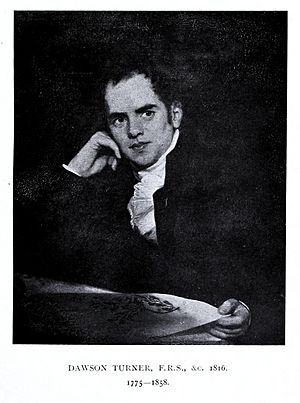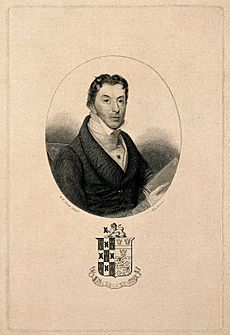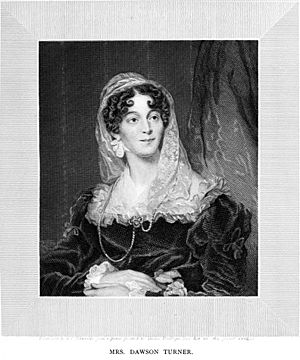Dawson Turner facts for kids
Dawson Turner (born October 18, 1775 – died June 21, 1858) was an English banker, a person who studied botany (plants), and an antiquary (someone who studies old things). He was especially interested in plants called cryptogams, which are plants that do not produce seeds or flowers, like ferns and mosses. He was also the father-in-law of famous botanist William Jackson Hooker and historian Francis Palgrave.
About Dawson Turner
His Early Life and Work
Dawson Turner was the son of James Turner, who ran the Gurney and Turner's Yarmouth Bank. His mother was Elizabeth Cotman. He went to school at North Walsham Grammar School in Norfolk. He also studied with a botanist named Robert Forby.
Later, he went to Pembroke College, Cambridge. But he left college early because his father was very ill. In 1796, he joined his father's bank.
A Love for Nature and History
After becoming a banker, Dawson Turner spent his free time studying plants. He loved collecting plant samples. In 1794, he offered to help James Sowerby, another plant expert. Turner wrote several books and worked with other botanists. In 1802, he became a Fellow of the Royal Society, which is a very important group for scientists. In 1816, he was also chosen as a member of the Royal Swedish Academy of Sciences.
Around 1820, his interest changed from plants to old objects and history. He and his children learned drawing from a famous artist named John Sell Cotman. Cotman became a good friend. They even traveled to Normandy together. They worked on a book called Architectural Antiquities of Normandy, which came out in 1822. Cotman made the pictures for the book.
Dawson Turner passed away in 1858. He is buried in Brompton Cemetery in London.
His Family
In 1796, Dawson Turner married Mary (1774–1850). She was the daughter of William Palgrave from Norfolk. Mary became a well-known artist, especially for her portraits. She made many drawings, and 78 of them are now kept at the National Portrait Gallery in London.
Dawson and Mary had 11 children:
- Maria Dawson Turner (1797–1872) married William Jackson Hooker, who was a botanist. Their son, Joseph Dalton Hooker, also became a botanist.
- Elizabeth Turner (1799–1852) married Francis Palgrave. He was a historian.
- Harriet Turner (1806–1869) married John Gunn in 1830. He was a clergyman and a naturalist.
- Hannah Sarah Turner (1808–) married Thomas Brightwen in 1839.
- Eleanor Jane Turner (1811–1895) married William Jacobson, a religious leader.
- Gurney Turner (1813–1848) had a son named Dawson Turner. This grandson played in the first international rugby match in 1871.
- Dawson William Turner (1815–1885) became an educationalist.
Dawson Turner was the father-in-law of Sir William Jackson Hooker and Sir Francis Palgrave. He was also the grandfather of Sir Joseph Dalton Hooker, the poet Francis Turner Palgrave, and Sir Robert Harry Inglis Palgrave.
After his first wife Mary died in 1850, Dawson Turner married Rosamund Matilda Duff. He then moved from Yarmouth to Barnes. In 1853, he retired to Lee Cottage in Old Brompton, where he lived until he died. His large collections were sold in auctions after he passed away.




